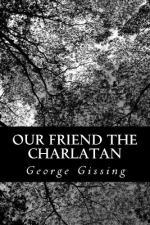Dyce let his eyes wander, but paid Tittle attention to what he saw. His guide was speaking in a dry, uninterested voice, she, too, seeming to have her thoughts elsewhere. They went out into the hall, looked into one or two other rooms, and began to ascend the stairs.
“There’s nothing of interest above,” said Constance, “except the view from the top of the house. But Lady Ogram would like you to see that, no doubt.”
Observing Constance as she went before him, Dyce was struck with a new dignity in her bearing. Notwithstanding her subordinate position at Rivenoak, and the unceremonious way in which Lady Ogram exercised authority over her, Constance showed to more advantage here than on her recent visit to Alverholme; she was more naturally self-possessed, and seemed a freer, happier person. The house garb, though decorous rather than ornamental, became her better than her walking-costume. Her well-shaped head and thoughtful, sensitive, controlled features, had a new value against this background of handsome furniture and all the appointments of wealth. She moved as if breathing the air that suited her.
From the terrace on the roof, their eyes commanded a wide and beautiful prospect, seen at this moment of the year in its brightest array of infinitely varied verdure. Constance, still in an absent tone, pointed out the features of the landscape, naming villages, hills, and great estates. Hollingford, partly under a canopy of smoke, lay low by its winding river, and in that direction Dyce most frequently turned his eyes.
“I felt very much obliged to you,” he said, “for your carefully written letter. But wasn’t there one rather serious omission?”
Speaking, he looked at Constance with a humorous twinkle of the eye. She smiled.
“Yes, there was. But, after all, it did no harm.”
“Perhaps not. I ought to have used more discretion on strange ground. By the bye, do you take an interest in the mill?”
“A good deal of interest. I think that what you said about it was, on the whole, true—though such an obvious improvisation.”
“Improvisation? In one sense, yes; I had to take in the facts of the case very quickly. But you don’t mean that you doubt my sincerity?”
“No, no. Of course not.”
“Come, Miss Connie, we must understand each other—”
She interrupted him with a look of frank annoyance.
“Will you do me the kindness not to call me by that name? It sounds childish—and I have long outgrown childhood.”
“What shall I call you? Miss Bride?”
“It is the usual form of address.”
“Good. I was going to say that I should like you to be clear about my position. I have come here, not in the first place with a hope of personal advantage, but to see if I can interest Lady Ogram in certain views which I hold and am trying to get accepted by people of influence. It happened that this affair of the mill gave me a good illustration of the theory I generally have to put in an abstract way. Your word ‘improvisation’ seems to hint that I shaped my views to the purpose of pleasing Lady Ogram—a plain injustice, as you will see if you remember the letter I wrote you.”




